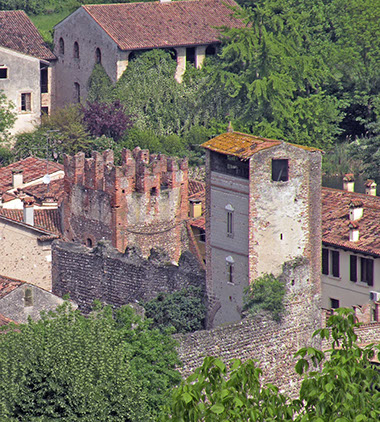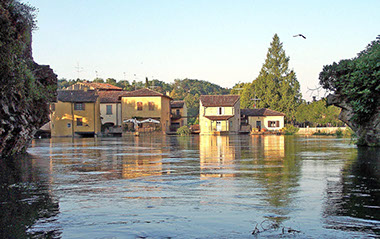Progetto di valorizzazione
del territorio di Valeggio sul Mincio
Castello Scaligero
di Borghetto
XIV SECOLO
Nel 1331 gli Scaligeri, signori di Verona, acquistarono dall’abbazia benedettina di San Zeno dei possedimenti nella Valle del Mincio.
Di seguito, costruirono il castello di Borghetto, inglobando fra le sue mura l’antica chiesetta romanica di Santa Maria della Masôn.
Il fortilizio, caposaldo occidentale della linea fortificata del Serraglio, aveva cinque torri.
Attualmente ne rimangono due, quella che permette l’accesso al borgo e quella retrostante la chiesa trasformata in campanile, sulla quale è ancora in uso un’antica campana fusa nel 1381.
Un piccolo fossato, percorso dalle acque del Mincio, circonda ancora la struttura.
Due ponti levatoi ne difendevano le entrate: quello che dava sulla strada che porta a Valeggio, e quello che si apriva sul Ponte San Marco.
Dismesso militarmente sul finire del XVI secolo dai veneziani, nel castello sono sorte delle abitazioni civili, il palazzetto della famiglia patrizia dei Borghetti e i mulini che hanno caratterizzato l’economia locale fino alla metà del XX secolo.
Ancora agli inizi del Novecento un massiccio portone di legno chiudeva l’accesso allo storico ponte, parte in muratura e parte in legno, che da secoli collega le opposte rive del Mincio.
Nel XIII secolo, furono probabilmente i Cavalieri Templari a costruire la prima passerella pedonale, per permettere ai numerosi pellegrini in transito di superare agevolmente il fiume. In passato, le autorità imposero che una parte del ponte rimanesse lignea, per distruggerla facilmente in caso di guerra.
Qui sono transitati grandi personaggi della storia europea fra cui: gli imperatori germanici Lotario e Federico Barbarossa, Napoleone Bonaparte, Francesco Giuseppe d’Austria, Carlo Alberto e Vittorio Emanuele II di Savoia, l’imperatore Napoleone III, ecc.
Sul ponte esisteva un’edicola settecentesca dedicata a San Giovanni Nepumoceno, un tempo invocato contro tutti i pericoli che potevano venire dall’acqua.
Ora, la statuetta del santo boemo è incastonata nelle vicine mura medievali e, al posto dell’edicola, un cippo ricorda il primo centenario della riunificazione politica dell’Italia (1861/1961), concretatasi fra le nostre colline durante il Risorgimento.
Borghetto
Scaligeri Castle
14th CENTURY
In 1331 the Scaligeri, the Lords of Verona, bought some properties in the Mincio valley from the Benedictine abbey of San Zeno.
Afterwards, they built Borghetto Castle, incorporating inside its walls the ancient romanesque church of St. Mary of the Temple.
The fortress, western stronghold of the fortified line of the Serraglio, had five towers.
Today only two are left: the one allowing the access to the medieval town and the one behind the church, which has been transformed into a bell tower, on which an ancient bell, melted in 1381, is still in use.
A small moat, in which the Mincio waters flow, ever naw surrounds the structure.
Two drawbridges defended its entrances. The castle lost its military function towards the end of the 16th century due to the intervention of the Venetians. Inside, civilian dwellings have risen over time: the small palace of the patrician family of the Borghetti and the mills that have characterised the local economy until the middle of the 20th century.
At the beginning of the last century a thick wooden front door still closed the access to the historical bridge, which was partly made of stones and partly wooden, and which has connected the opposite banks of the Mincio for centuries.
In the 13th century, the first pedestrian gangway was probably built by the Knights Templar to allow the numerous pilgrims to cross the river easily. In the past, the authorities dictated that a part of the bridge had to be kept in wood, in order to destroy it easily, in case of war.
Famous personalities of European history have crossed this bridge, among them: the Germanic emperors Lothair and Frederick Barbarossa, Napoleon Bonaparte, Franz Joseph of Austria, Charles Albert and Victor Emmanuel II of Savoy, the emperor Napoleon III of France, and many others.
On the bridge there was a 18th century shrine dedicated to Saint John Nepomuk, once invoked for protection against all dangers coming from the water.
Today, the little statue of the bohemian saint is nestled in the nearby medieval walls; in the place of the shrine, a memorial stone reminds us the first centenary of the Italian political reunification (1861-1961), also achieved in the hills around Valeggio during the Risorgimento wars.
Scaligerkastell
von Borghetto
13.-14. Jhr.
Mittelalterliche Route
Im Jahr 1331 erwarben die Scaliger, die Herren von Verona, von der Benediktinerabtei San Zeno Besitztümer im Mincio-Tal. Darauf ließen sie die Burg von Borghetto errichten, in der die Mauern der alten romanischen Kirche Santa Maria della Masôn einverleibt wurden.
Die Festung mit ihren fünf Türmen diente als westliches Bollwerk für die Serraglio Verteidigungslinie. Heute sind noch zwei Türme erhalten: der Turm am Zugang zur Ortschaft und der Turm hinter der Kirche, der in einen Glockenturm umgewandelt wurde, auf dem noch die alte im Jahr 1381 gegossene Glocke in Betrieb ist.
Ein kleiner Burggraben, in dem die Gewässer des Mincio fließen, umgibt die Anlage. Der Eingang war mit zwei Zugbrücken geschützt: eine führte auf die Straße nach Valeggio, die andere ging auf die San-Marco-Brücke.
Im 16. Jahrhundert wurde das Kastell von den Venezianern nicht mehr für militärische Zwecke benutzt, sondern wurden Wohnungen, der Palast der Adeligenfamilie Borghetti und die Mühlen errichtet, die die lokale Wirtschaft ab der Mitte des 20. Jahrhundert geprägt haben.
Noch am Beginn des 20. Jahrhundert verschloss ein massives Holztor den Zutritt zur historischen Brücke, zum Teil gemauert und zum Teil aus Holz, der seit Jahrhunderten die gegenüberliegenden Ufer des Mincios verband.
Im 13. Jahrhundert errichteten wahrscheinlich die Tempelritter die ersten Laufstege, damit die zahlreichen vorbeiziehenden Pilger bequem den Fluss überqueren konnten.
In der Vergangenheit beschlossen die Behörden, dass ein Teil der Brücke aus Holz bleiben sollte, um sie im Falle eines Krieges leicht zerstören zu können. Hier sind große Persönlichkeiten der europäischen Geschichte durchgezogen, darunter die deutschen Kaiser Lothar I. und Friedrich I., Napoleon Bonaparte, Franz Josef I., Karl Albert und Viktor Emanuel II. von Savoyen, der Kaiser Napoleon III. usw.
Auf der Brücke gab es eine Ädikula aus dem 18. Jahrhundert, die Johannes Nepomuk geweiht war, der einst bei Gefahren aus dem Wasser angerufen wurde. Heute ist die kleine Statue des böhmischen Heiligen anstelle der Ädikula in der angrenzenden mittelalterlichen Mauer eingelassen.
Ein Säulenstumpf erinnert an die erste Jahrhundertfeier der politischen Vereinigung Italiens (1861/1961), die sich während des Risorgimentos zwischen unseren Bergen ereignete.


San Giovanni Nepumoceno

© 2019
Comune di Valeggio sul Mincio (VR)
Associazione Percorsi


